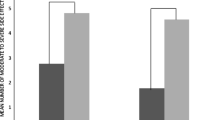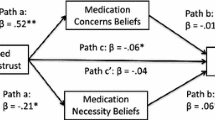Abstract
Background Ethnic diversity is increasingly encountered in the HIV-infected population in North America, and it is unknown if beliefs surrounding illness and treatment vary among different ethnic groups. Objective Our objectives were to determine whether self-reported adherence, illness perceptions and treatment beliefs regarding HIV differ based on ethnicity. Setting This study was conducted during outpatient HIV clinic visits between March 1, 2010 and April 30, 2010 at two hospital-based clinics in Edmonton, AB, Canada. Methods A cross-sectional sample of 65 patients on antiretroviral therapy (34 Caucasian, 23 Aboriginal, and 8 from other ethnic groups) attending hospital-based clinics completed a self-administered survey; medical records were reviewed for demographic and treatment information. Main outcome measure An ANOVA with covariates was performed to measure variation of beliefs and adherence between ethnic groups. Results Mean self-reported adherence in the past week and past month was high (96 %) and the majority of patients (78.5 %) had a viral load <40 copies/mL. Patients had high perceived necessity scores and a low degree of perceived concern with antiretroviral therapy. In our study, treatment beliefs, illness perceptions, and self-reported adherence did not vary between ethnicities (p > 0.05). Conclusion Treatment beliefs, illness perceptions, and adherence appear to be largely similar in English-speaking patients with diverse ethnic backgrounds who have been on treatment for at least 3 months. Strong supports may overcome any cultural differences in treatment beliefs that were expected at the outset.
Similar content being viewed by others
References
Bhaskaran K, Hamouda O, Sannes M, et al. Changes in the risk of death after HIV seroconversion compared with mortality in the general population. JAMA. 2008;300(1):51–9.
Paterson DL, Swindells S, Mohr J, et al. Adherence to protease inhibitor therapy and outcomes in patients with HIV infection. Ann Int Med. 2000;133(1):21–30.
Hogg RS, Heath K, Bangsberg D, et al. Intermittent use of triple-combination therapy is predictive of mortality at baseline and after 1 year of follow-up. AIDS. 2002;16(7):1051–8.
Clavel F, Hance AJ. HIV drug resistance. N Engl J Med. 2004;350(10):1023–35.
Raffa JD, Tossonian HK, Grebely J, Petkau AJ, DeVlaming S, Conway B. Intermediate highly active antiretroviral therapy adherence thresholds and empirical models for the development of drug resistance mutations. J Acquir Immune Defic Syndr. 2008;47(3):397–9.
Panel on Antiretroviral Guidelines for Adults and Adolescents. Guidelines for the use of antiretroviral agents in HIV-1-infected adults and adolescents. Department of Health and Human Services January 10, 2011:1–166. Available at http://www.aidsinfo.nih.gov/ContentFiles/AdultandAdolescentGL.pdf.
Bangsberg DR. Less than 95% adherence to nonnucleoside reverse-transcriptase inhibitor therapy can lead to viral suppression. Clin Infect Dis. 2006;43(7):939–41.
Holzemer WL, Corless IB, Nokes KM, et al. Predictors of self-reported adherence in persons living with HIV disease. AIDS Patient Care STDS. 1999;13(3):185–97.
Moatti JP, Carrieri MP, Spire B, Gastaut JA, Cassuto JP, Moreau J. Adherence to HAART in French HIV-infected injecting drug users: the contribution of buprenorphine drug maintenance treatment. AIDS. 2000;14(2):151–5.
Gifford AL, Bormann JE, Shively MJ, Wright BC, Richman DD, Bozzette SA. Predictors of self-reported adherence and plasma HIV concentrations in patients on multidrug antiretroviral regimens. J Acquir Immune Defic Syndr. 2000;23(5):386–95.
Stone VE, Hogan JW, Schuman P, et al. Antiretroviral regimen complexity, self-reported adherence, and HIV patients’ understanding of their regimens: survey of women in the her study. J Acquir Immune Defic Syndr. 2001;28(2):124–31.
Atkinson MJ, Petrozzino JJ. An evidence-based review of treatment-related determinants of patients’ nonadherence to HIV medications. AIDS Patient Care STDS. 2009;23(11):903–14.
Mills EJ, Nachega JB, Bangsberg DR, et al. Adherence to HAART: a systematic review of developed and developing nation patient-reported barriers and facilitators. PLoS Med. 2006;3(11):e438.
Ammassari A, Trotta MP, Murri R, et al. Correlates and predictors of adherence to highly active antiretroviral therapy: overview of published literature. J Acquir Immune Defic Syndr. 2002;31(Suppl 3):S123–7.
Eldred LJ, Wu AW, Chaisson RE, Moore RD. Adherence to antiretroviral and pneumocystis prophylaxis in HIV disease. J Acquir Immune Defic Syndr Hum Retrovirol. 1998;18(2):117–25.
Haubrich RH, Little SJ, Currier JS, et al. The value of patient-reported adherence to antiretroviral therapy in predicting virologic and immunologic response. AIDS. 1999;13(9):1099–107.
Kleeberger CA, Phair JP, Strathdee SA, Detels R, Kingsley L, Jacobson LP. Determinants of heterogeneous adherence to HIV-antiretroviral therapies in the Multicenter AIDS Cohort Study. J Acquir Immune Defic Syndr. 2001;26(1):82–92.
Catz SL, Kelly JA, Bogart LM, Benotsch EG, McAuliffe TL. Patterns, correlates, and barriers to medication adherence among persons prescribed new treatments for HIV disease. Health Psychol. 2000;19(2):124–33.
Oh DL, Sarafian F, Silvestre A, et al. Evaluation of adherence and factors affecting adherence to combination antiretroviral therapy among White, Hispanic, and Black men in the MACS Cohort. J Acquir Immune Defic Syndr. 2009;52(2):290–3.
Gellad WF, Haas JS, Safran DG. Race/ethnicity and nonadherence to prescription medications among seniors: results of a national study. J Gen Int Med. 2007;22(11):1572–8.
Horne R, Buick D, Fisher M, Leake H, Cooper V, Weinman J. Doubts about necessity and concerns about adverse effects: identifying the types of beliefs that are associated with non-adherence to HAART. Int J STD AIDS. 2004;15(1):38–44.
Moss-Morris R, Weinman J, Petrie KJ, Horne R, Cameron LD, Buick D. The revised Illness Perception Questionnaire (Ipq-R). Psychol Health. 2002;17(1):1–16.
Horne R, Graupner L, Frost S, Weinman J, Wright SM, Hankins M. Medicine in a multi-cultural society: the effect of cultural background on beliefs about medications. Soc Sci Med. 2004;59(6):1307–13.
Lewis LM, Ogedegbe G. Understanding the nature and role of spirituality in relation to medication adherence: a proposed conceptual model. Holist Nurs Pract. 2008;22(5):261–7.
Morgan M, Figueroa-Munoz JI. Barriers to uptake and adherence with malaria prophylaxis by the African community in London, England: focus group study. Ethn Health. 2005;10(4):355–72.
Voyer P, Rail G, Laberge S, Purnell L. Cultural minority older women’s attitudes towards medication and implications for adherence to a medicine regimen. Divers Health Soc Care. 2005;2(1):47–61.
Grewal K, Stewart DE, Grace SL. Differences in social support and illness perceptions among South Asian and Caucasian patients with coronary artery disease. Heart Lung. 2010;39(3):180–7.
Clifford S, Barber N, Horne R. Understanding different beliefs held by adherers, unintentional nonadherers, and intentional nonadherers: application of the necessity–concerns framework. J Psychosom Res. 2008;64(1):41–6.
Thrasher AD, Earp JA, Golin CE, Zimmer CR. Discrimination, distrust, and racial/ethnic disparities in antiretroviral therapy adherence among a national sample of HIV-infected patients. J Acquir Immune Defic Syndr. 2008;49(1):84–93.
van Servellen G, Lombardi E. Supportive relationships and medication adherence in HIV-infected, low-income Latinos. West J Nurs Res. 2005;27(8):1023–39.
Acknowledgments
The authors would like to thank Mr. Suliman Al Ghurair for his assistance with the statistical analysis and Dr. Sheri Koshman for her assistance with project development and her input into the preparation of the manuscript.
Funding
This research was funded by internal research funding provided by the University of Alberta.
Conflicts of interest
The authors have no conflicts of interest to disclose.
Author information
Authors and Affiliations
Corresponding author
Rights and permissions
About this article
Cite this article
Gunther, M., Foisy, M., Houston, S. et al. Treatment beliefs, illness perceptions, and non-adherence to antiretroviral therapy in an ethnically diverse patient population. Int J Clin Pharm 36, 105–111 (2014). https://doi.org/10.1007/s11096-013-9866-9
Received:
Accepted:
Published:
Issue Date:
DOI: https://doi.org/10.1007/s11096-013-9866-9




